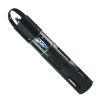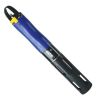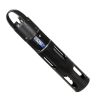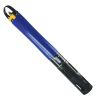YSI EXO NitraLED UV Nitrate Sensor
Features
- Available at a fraction of the cost of other lamp-based nitrate sensors
- Built-in corrections for natural organic matter (NOM) and turbidity
- Designed for use with EXO1, EXO2, EXO3, or EXO2s water quality sondes
- Expedited repair and warranty service
- Lifetime technical support
- More
| Accuracy (0-10mg/L) |
± 0.1 mg/L–N or 5% of reading, w.i.g. (within 2°C) |
|---|---|
| Accuracy (10-30mg/L) |
± 7% of reading |
| Depth Rating | 250 m |
| Drift / Stability |
≤ 0.2 mg/L–N |
| Equipment used with | EXO™ |
| Light Source | UV LED (x2) |
| Lower Detection Limit |
0.005 mg/L–N |
| Measurement Range |
0-30 mg/L–N |
| Medium |
Fresh water |
| Nominal Wavelengths | 235 nm, 275 nm |
| Operating Temperature | 5-35°C |
| Pathlength | 10 mm |
| Precision |
≤ 2% Coefficient of Variation (CV) |
| Response Time | T95 < 30 seconds |
| Sensor | Optical, absorbance |
| Storage Temperature | -20-80 °C |
| Warranty |
2 years |
- YSI EXO NitraLED UV Nitrate Sensor Specifications
- YSI EXO NitraLED UV Nitrate Sensor Handbook
- YSI EXO NitraLED UV Nitrate Sensor Corrections for Turbidity and NOM
- YSI EXO NitraLED UV Nitrate Sensor Site Specific Correction Procedure
- YSI EXO NitraLED UV Nitrate Sensor Installation Guide
- YSI EXO Water Quality Sonde Specifications
- YSI EXO Water Quality Sonde Manual
In The News
Sewage an Unseen and Ignored Threat to Coral Reefs and Human Health
It’s an open, dirty secret that the ocean is used as the ultimate sewage solution. Each year trillions of gallons of untreated waste are sent to the ocean due to a widespread lack of sanitation technology or infrastructure that needs updating as cities and populations grow. As the impact of untreated sewage on the ocean becomes clearer, attention to the problem and strategies for dealing with it have not kept up. “This is a massive problem and it’s been largely ignored,” said Stephanie Wear, senior scientist and strategy advisor for The Nature Conservancy. Wear has turned her attention to raising the alarm about the effects of sewage on coral reefs, which often loses airtime to other pressing issues like climate change and overfishing.
Read MoreCarbon and Nutrient Monitoring in the Great Lakes Using Satellite Observations
Carbon and nutrients are the foundation of lake food webs and play an important role in the chemical and physical processes that shape aquatic ecosystems and various lake dynamics. Studying these cornerstones can help improve understanding of other lake conditions like harmful algal blooms, hypoxia, and phytoplankton community composition. The way in which these characteristics are monitored varies, though many rely on a proxy approach wherein parameters are extrapolated from the measurement of a different parameter. An assistant professor at Cleveland State University, Brice Grunert, is working to improve current strategies and take a satellite approach to monitoring the Great Lakes.
Read MoreRestoring North Texas Streams to Historical Flows
North Texas is one of the fastest-growing regions in the state, an area that is expected to face increasing water needs. In order to meet these demands, the Upper Trinity Regional Water District ( UTRWD ) is building Lake Ralph Hall near Ladonia in southeast Fannin County, Texas. The lake has been in the works since 2003, with construction finally beginning in 2021. The population of the UTRWD is expected to grow 5-fold over the next 50 years, leading to increased water use. Ed Motley, Program Manager with the UTRWD stresses that even with conservation and reuse, new sources like Lake Ralph Hall are essential to meeting near-term and long-term water needs to support regional growth.
Read More















